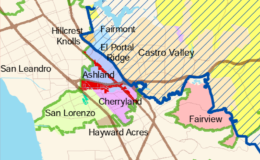Really well written article. Please see today’s Castro Valley Forum!
Skeptical MAC delays action on medical marijuana changes
- By : Peter Rosen
- Category : Alameda County, Economic Development, Governance
- Tags: alameda county, Board of Supervisors, Cannabis, MAC, marijuana

A skeptical Castro Valley Municipal Advisory Council (MAC) discussed an update to the Alameda County General Code on Monday that would increase the number of medical marijuana dispensaries allowed in the unincorporated areas of Alameda County from three to six, reduce the buffer zones around dispensaries, and refer to it as “cannabis” rather than “marijuana.”
This draft ordinance on medical cannabis dispensaries came before the MAC and the Unincorporated Services meetings in June, the Agriculture Advisory Meeting in July, and came back to MAC with an audience of about 50 people.

Proposed Changes in Ordinances
According to a summary by County Counsel and the Community Development Agency, the proposed ordinance would:
- Increase the number of dispensaries allowed in the unincorporated area from three to six. A maximum of four of these can be in the Western portion (which includes Castro Valley) and two in the Eastern Area.
- Allow the unlimited delivery of medical cannabis
- Remove the 20 pound limit on storage for dispensaries.
- Allow cultivation, as long as it is by one of the existing dispensaries.
- Allow the sale of edibles, as long as they are manufactured according to health code requirements (and it must be produced in a commercial facility).
- Reduce the buffer zone between the dispensaries and “sensitive receptors” (e.g. schools) from 1000 feet to 600 feet.

The Alameda County Sheriff Department is opposed to all of these changes. Sgt. Bret Scheuller of the Alameda County Sheriff’s Office stated that this ordinance is “industry driven, and not community driven.”
Is it “Marijuana” or “Cannabis”?
The ordinance would also change the word that Alameda County uses to describe what is being regulated, revising the General Code to use the term “cannabis” rather than “marijuana.” According to an article in High Times, “Marijuana is what prohibition supporters called cannabis as they sought to demonize its use and criminalize its consumers.” Further, it writes:
Frankly, the argument for legalization is best advanced using the terminology that is most familiar to the public. It is most important, these days, to change the laws. Changing the terminology, though, should be considered another important obligation for the advocates and supporters of legalization. Cannabis is an elegant botanical compound. Cannabis rules: Call things by their right name. It’s a matter of respect. And history.
Public Comment
Following the staff presentation, five people spoke in favor of the new ordinance, and seven people spoke against it. Most of the arguments in favor of the ordinance focused on the health benefits of medical marijuana.
The arguments against the ordinance challenged the health benefits, questioned the need for this, and asked why this ordinance needs to be updated right now and so quickly. Many questioned the need to update an ordinance without knowing the impact of the possible legalization of recreational marijuana with the California Marijuana Legalization Initiative (Proposition 64) on the November ballot.
A recent Orange County Register article was cited that discussed how legalizing recreational use of Marijuana might affect medical marijuana patients. Some of the speakers pointed out that a new Harborside location is opening soon in San Leandro and that there are currently over 100 local companies in the area that deliver medical marijuana to people’s doorsteps.
MAC Discussion
The questions by the MAC members regarding the ordinance included:
- Chuck Moore asked, “Why is this needed? Will people not drive? Are the two dispensaries that are currently open too busy?”
- MAC Chair Marc Crawford was concerned that the ordinance would only allow the two current dispensaries the ability to cultivate marijuana in the Unincorporated Area. He questioned the intent that encouraged a virtual monopoly between the two dispensaries.
The MAC also addressed the process for the implementation of the new ordinances, particularly how it related to the timing of Proposition 64.
- Linda Tangren pointed out that there is a State of California law that will take effect in 2018, and much of this ordinance is included in this law, so she asked why the ordinance is needed now.
- MAC Vice Chair Ken Carbone suggested that the County should hold a series of workshops that includes the public, the industry and county staff, as is typical for a redraft of an ordinance. He also suggested that the ordinance should be divided into parts and discussed separately.
- Crawford said that he was very concerned with the timeline and said that in 20 years of following these things, it is rare for something to be this fast-tracked. He suggested that the County should wait until November, after the fate of Proposition 64 is known, and that the County should hold a series of workshops that would include the stakeholders, not structured hearings like Monday’s meeting.
Meeting Outcomes and Next Steps

The MAC did not make a resolution, nor vote on the ordinance.
The ordinance will go to a series of other county meetings for presentation and public comment, and ultimately to the Alameda County Board of Supervisors for the final decision. There will be another presentation to the San Lorenzo Village Homes Association on Thursday, September 15.
According to timeline in the meeting packet and on the Community Development Agency website, the Supervisors are expected to act on the ordinance on November 22 with the changes going into effect on December 23.
Michael Kusiak contributed to this post.


